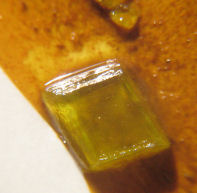
If ascorbic acid solution is unavailable, water may be used.Ħ.
#Melt chromium chloride crystals skin
Wash exposed skin areas with a 10 to 20% ascorbic acid solution for 15 minutes. If eye exposure has occurred, eyes must be flushed with lukewarm water for at least 15 minutes.ĥ. Remove contaminated clothing as soon as possible.Ĥ. Emergency personnel should avoid self- exposure to chromic chloride.ģ. Obtain authorization and/or further instructions from the local hospital for administration of an antidote or performance of other invasive procedures.ġ. If breathing is labored, administer oxygen or other respiratory support.ģ. If not breathing, provide artificial respiration. Evaluate vital signs including pulse and respiratory rate, and note any trauma. Emergency personnel should avoid self-exposure to chromic chloride.Ģ. Rescue vehicles should carry supplies such as plastic sheeting and disposable plastic bags to assist in preventing spread of contamination.ġ. Air-purifying or supplied-air respiratory equipment should also be worn, as necessary. Emergency personnel should wear protective clothing appropriate to the type and degree of contamination. Hospitalization is essential.Įmergency Life-Support Procedures: Acute exposure to chromic chloride may require decontamination and life support for the victims. Delayed effects such as hepatic encephalopathy, pneumoconiosis, acute hepatitis, renal failure, anemia, and thrombocytopenia may take as many as 7 days to manifest.

Pulmonary edema, bronchial asthma, circulatory collapse, and shock may also occur. Signs and Symptoms of Acute Chromic Chloride Exposure: Acute exposure to chromic chloride may produce signs and symptoms that include corneal injury, oral burns, deep perforating ulcers, gastrointestinal inflammation, and hemorrhage. Warnings: Effects may not appear for several days.


 0 kommentar(er)
0 kommentar(er)
